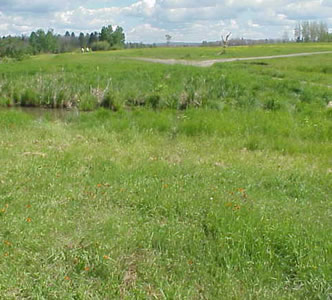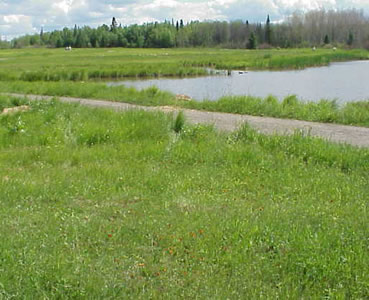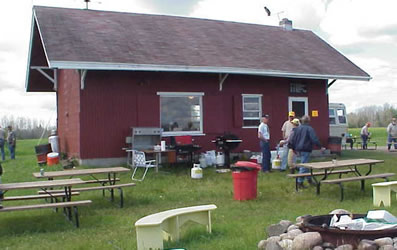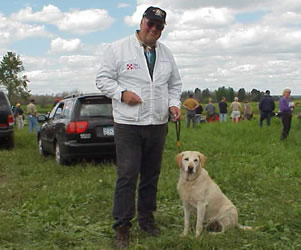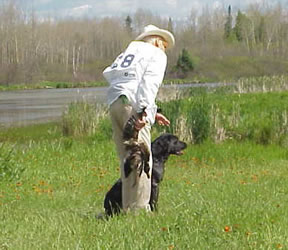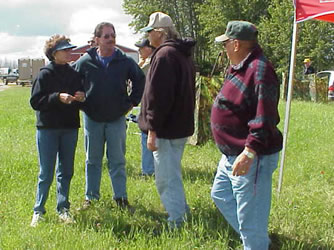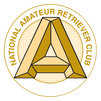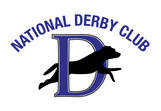Thursday, June 21, 2001 |
Test 6 - Water Triple
A pleasantly cool, partly sunny day dawned Thursday. Temperatures were in the mid 50's and NO rain was forecast. The 22 mile trip from Hibbing to Virginia was lush and green with summer foliage except for deciduous tees, bare as winter from the effects of ravenous tent caterpillars. They must have found delphiniums less tasty as numerous patches of blue, pink and white ones peppered roadsides.
The site for test 6 was located behind the MIR clubhouse and final preparations were made as participants arrived about 7 a.m.
The series was a water triple with a retired gun station. The line was on the left end of a long , medium sized, cattail edged pond that had a number of points and a group of duck decoys resting in a small bay near the far shore. A gravel road encircled the pond about 3/4 of the the way. The first gun station was located to the deep right on the far shore of the pond. They threw a dead rooster pheasant flat to the left where it fell in fairly tall cover 210 yds from line. A second set stood much closer to the line on the far left, across a small slough, on top a gentle slope. They threw a dead duck flat to the right that fell in shorter, sparse cover 125 yards away. The third, flyer station was also across the pond, nearly equidistant between the left and right marks, but deeper and also on the crest of a slope rising form the pond. They shot a flying duck to the left that fell in the grassy cover nearly 165 yards out. The order was right retired; left; middle flyer. As the dog was sent for the flyer, the far right guns retired into the woods behind them. The judges allowed a few seconds for readying the running dog before calling for the birds. (Contestants did not signal when ready.)
By 7:30 the test dogs were called to demonstrate the test. The first one did well while the second handled on the retired bird. It took nearly 10 minutes to complete. A bit of cover grooming was needed before the first competing dog ran as the second test dog hit a hidden stump near a tree on the left and was rolled. After the grass was trimmed around it, dogs could see the hazard and avoid it.
At 8 a.m., the first running dog, # 11 stepped up to try the marks. To recover the exciting flyer, dogs had to slice into the end of the pond, then drive up the hill to the fall. There was a winding gravel road between the shore an fall area. Some dogs stayed on the road until they arrived on the right side of the station. Most recovered and worked their way over to the bird with either a hook or moderate hunt. Others "shopped" a bit before finding their flyer - one or two nearly to the retired bird area. Dogs were then sent for the close left mark. There was little trouble on that bird, and only short hunts usually occurred. The far, retired mark proved the most difficult. To recover it, dogs had to angle into and cross the pond staying close to the far shore for a good distance. The pond had formidable cattails lining it and dogs had to decide when they could exit the water. Those exiting early could be tempted to return to the flyer - which a number did - and had to be handled to the fall. Others treated the retired mark as a channel blind and swam all the way down the middle of the pond an disappeared into the thick cover at the far end. There they hunted unseen, a few for a considerable time, until they reappeared either on the right shore or left area of the fall. Some visited the guns, then figured out where the bird should be. Since it was a pheasant, it was not easy to wind and perhaps dogs were expecting another duck since they had two previously. A few drove the distance nearly to the fall, then made a sharp left, going up the hill away from the bird and near the flyer guns.
From the starting dog, #11 through #99, 10 had handled and there was a pick up along with a number of hard, long hunts - usually on the retired mark. Shortly after 1:30 p.m., an announcement was made the this would be the only test of the day. Estimated finish time was 5:30 +.
Callbacks arrived quite promptly and only 39 potential NAFC's remained. The 16 dropped were: 3, 6, 9, 11, 12, 14, 21, 26, 37, 53, 61, 63, 70, 71, 78 and 98. Dog 22 would initiate the 7th series. The seventh and eighth would be a land blind and a water blind in the clubhouse area. Test dogs at 6:30 a.m. - first running dog at 7 a.m.
The site for test 6 was located behind the MIR clubhouse and final preparations were made as participants arrived about 7 a.m.
The series was a water triple with a retired gun station. The line was on the left end of a long , medium sized, cattail edged pond that had a number of points and a group of duck decoys resting in a small bay near the far shore. A gravel road encircled the pond about 3/4 of the the way. The first gun station was located to the deep right on the far shore of the pond. They threw a dead rooster pheasant flat to the left where it fell in fairly tall cover 210 yds from line. A second set stood much closer to the line on the far left, across a small slough, on top a gentle slope. They threw a dead duck flat to the right that fell in shorter, sparse cover 125 yards away. The third, flyer station was also across the pond, nearly equidistant between the left and right marks, but deeper and also on the crest of a slope rising form the pond. They shot a flying duck to the left that fell in the grassy cover nearly 165 yards out. The order was right retired; left; middle flyer. As the dog was sent for the flyer, the far right guns retired into the woods behind them. The judges allowed a few seconds for readying the running dog before calling for the birds. (Contestants did not signal when ready.)
By 7:30 the test dogs were called to demonstrate the test. The first one did well while the second handled on the retired bird. It took nearly 10 minutes to complete. A bit of cover grooming was needed before the first competing dog ran as the second test dog hit a hidden stump near a tree on the left and was rolled. After the grass was trimmed around it, dogs could see the hazard and avoid it.
At 8 a.m., the first running dog, # 11 stepped up to try the marks. To recover the exciting flyer, dogs had to slice into the end of the pond, then drive up the hill to the fall. There was a winding gravel road between the shore an fall area. Some dogs stayed on the road until they arrived on the right side of the station. Most recovered and worked their way over to the bird with either a hook or moderate hunt. Others "shopped" a bit before finding their flyer - one or two nearly to the retired bird area. Dogs were then sent for the close left mark. There was little trouble on that bird, and only short hunts usually occurred. The far, retired mark proved the most difficult. To recover it, dogs had to angle into and cross the pond staying close to the far shore for a good distance. The pond had formidable cattails lining it and dogs had to decide when they could exit the water. Those exiting early could be tempted to return to the flyer - which a number did - and had to be handled to the fall. Others treated the retired mark as a channel blind and swam all the way down the middle of the pond an disappeared into the thick cover at the far end. There they hunted unseen, a few for a considerable time, until they reappeared either on the right shore or left area of the fall. Some visited the guns, then figured out where the bird should be. Since it was a pheasant, it was not easy to wind and perhaps dogs were expecting another duck since they had two previously. A few drove the distance nearly to the fall, then made a sharp left, going up the hill away from the bird and near the flyer guns.
From the starting dog, #11 through #99, 10 had handled and there was a pick up along with a number of hard, long hunts - usually on the retired mark. Shortly after 1:30 p.m., an announcement was made the this would be the only test of the day. Estimated finish time was 5:30 +.
Callbacks arrived quite promptly and only 39 potential NAFC's remained. The 16 dropped were: 3, 6, 9, 11, 12, 14, 21, 26, 37, 53, 61, 63, 70, 71, 78 and 98. Dog 22 would initiate the 7th series. The seventh and eighth would be a land blind and a water blind in the clubhouse area. Test dogs at 6:30 a.m. - first running dog at 7 a.m.

